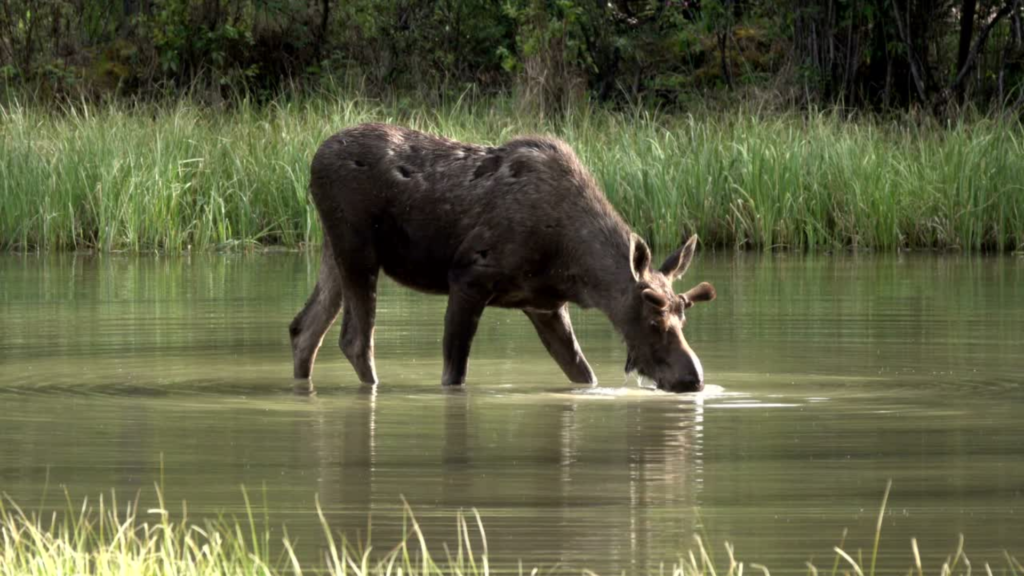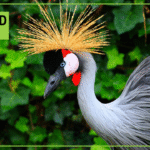
Majestic Moose: Exploring the Gentle Giants of the Wilderness
Watch the Full Video on YouTube:
Moose Subspecies: Different Giants Around the World
While there’s only one species of moose (Alces alces), there are several subspecies based on their geographical locations. Each subspecies has unique adaptations to the environments they live in, though they all share the general traits of being large, solitary, and well-adapted to cold climates.
Alaskan or Yukon Moose (Alces alces gigas)
The Alaskan moose, also known as the Yukon moose, is the largest of all moose subspecies. Found primarily in Alaska, the Yukon, and parts of Canada, these moose are true giants. Bulls (males) can stand up to 7.5 feet at the shoulder and weigh over 1,800 pounds. Their antlers are also the largest among moose, sometimes spanning over 6.5 feet from tip to tip.found in North America, are the largest, with some males weighing over 1,800 pounds!
Fun Fact: The largest Alaskan moose on record weighed a staggering 1,808 pounds!

Canadian Moose (Alces alces americana)
The Canadian moose is slightly smaller than its Alaskan cousin but still a massive animal. Found across Canada and in parts of the northern United States, particularly the Rocky Mountains, Canadian moose are typically between 900 and 1,400 pounds. Their antlers are large but generally smaller than those of Alaskan moose, usually around 5-6 feet wide.
Fun Fact: Canadian moose are frequently spotted in the wilds of Ontario, Quebec, and the Maritimes, and they are a common symbol of Canadian wildlife.

Eastern Moose (Alces alces americana)
The Eastern moose, a subspecies of the Canadian moose, is found in the northeastern United States, including states like Maine, New Hampshire, and Vermont, as well as parts of Canada. Though closely related to the Canadian moose, the Eastern moose tends to be slightly smaller, with bulls weighing between 800 and 1,300 pounds.
Fun Fact: Maine is home to the largest population of Eastern moose in the United States, with over 60,000 moose in the state.

Eurasian Moose (Alces alces alces)
The Eurasian moose, also known as the European elk, is found across northern Europe and Asia. They range from Scandinavia and the Baltic States to Russia and Siberia. Though slightly smaller than the Alaskan moose, Eurasian moose are still impressive animals, with bulls weighing between 800 and 1,500 pounds. Their antlers tend to be more slender and less palmate (broad and flat) than those of North American moose.
Fun Fact: In Sweden and Norway, moose are called “elg” or “älg” and are a cultural icon. Moose hunting is a major activity in these countries, and moose often appear on road signs as a warning to drivers!

Shiras Moose (Alces alces shirasi)
The Shiras moose, also known as the Wyoming moose, is the smallest subspecies of moose. These moose are found in the Rocky Mountains, particularly in Wyoming, Montana, and Colorado. Bulls typically weigh between 600 and 1,200 pounds, and their antlers, while still large, are more slender compared to other moose subspecies.
Fun Fact: Shiras moose are often considered the most elusive moose subspecies, as they prefer to live in remote, hard-to-reach areas of the Rocky Mountains.

Siberian Moose (Alces alces pfizenmayeri)
The Siberian moose, a subspecies of the Eurasian moose, is found in the remote forests of Siberia and parts of Mongolia. These moose are adapted to some of the harshest environments on Earth, with long, cold winters and short summers. They are similar in size to the Eurasian moose but may have thicker coats to survive the freezing temperatures of their habitat.
Fun Fact: Siberian moose have been known to survive in temperatures as low as -40°F!

“In the stillness of the forest, the moose moves with quiet grace—its size a testament to the strength of nature, and its presence a reminder of the wild’s enduring beauty.”

Life Cycle: From Calves to Giants
Moose typically live up to 15-20 years in the wild, though many factors, including predators, accidents, or disease, can affect their longevity. Female moose, called cows, give birth to calves after an 8-month gestation period, usually in the spring. These calves are quick learners, standing and walking within hours of being born.
Moose calves stick close to their mothers for the first year of life, learning to navigate the wilderness and avoid predators. By the time they’re a few months old, they can outrun most threats, thanks to their powerful legs. Moose can run up to 35 miles per hour when necessary—an impressive feat for such a large animal!


Moose and Humans: Coexisting with Giants
While moose are generally shy and prefer to avoid humans, they can sometimes be spotted wandering into towns, especially in areas like Alaska and Canada, where human development overlaps with moose habitats. In most cases, these gentle giants are more interested in foraging than interacting with people. However, like any wild animal, moose can become dangerous if they feel threatened.
During the fall rutting season, bulls can be particularly aggressive as they compete for mates. Similarly, cows with calves are highly protective and may charge if they perceive a threat. If you’re lucky enough to spot a moose in the wild, it’s always best to admire them from a safe distance!
Fun Facts About Moose
- In winter, moose often migrate to lower elevations where snow is less deep, making it easier for them to move around.
- Moose can swim up to 6 miles per hour and keep going for several hours without rest.
- Their antlers can weigh up to 40 pounds!
- Moose have a great sense of smell, allowing them to detect food and predators from far away.
- Unlike deer, moose don’t flee at the first sign of danger; they tend to stand their ground.
About Moose
- Habitat: Forest, Freshwater (since moose are often found near lakes, rivers, and wetlands)
- Animal Classification: Mammals
- Species Family: Cervidae (deer family)
- Region: North America, Northern Europe, Asia (specify regions relevant to the video)
- Conservation Status: Least Concern (or specific status if focusing on a regional population)
- Characteristics/Behaviors: Herbivorous, Solitary, Antlers, Migratory (in some populations)
Conclusion: The Majesty of Moose
From their towering height to their incredible swimming abilities, moose are truly one of nature’s most impressive creatures. Whether they’re wading through lakes in search of aquatic plants or roaming the vast boreal forests, these gentle giants are a testament to the beauty and resilience of the wild. Next time you’re out in nature, keep your eyes peeled—you might just spot a moose on the move!
Stay curious and explore more about wildlife with us at BearBunk! Don’t forget to share your thoughts in the comments below. Have you ever seen a moose in the wild? What’s your favorite fact about these amazing animals?














Leave a Reply